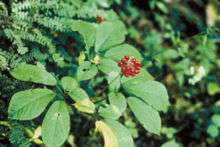Adaptogen

Adaptogens or adaptogenic substances, compounds, herbs[1] or practices refer to the pharmacological concept[2] whereby administration results in stabilization of physiological processes and promotion of homeostasis, for example, decreased cellular sensitivity to stress. The European Medicines Agency stated in a 2008 reflection paper that the concept requires additional clinical and preclinical research, and is therefore not accepted into current terminology.[3]
Most of the studies conducted on adaptogens were performed in the Soviet Union, Korea, and China before the 1980s and have been dismissed for various methodological flaws, leading to a conclusion that the term is not accepted in pharmacological and clinical practice as used in the European Union.[3]
History
The concept of adaptogens was originally created in 1947 to describe a substance that may increase resistance to stress.[3] Adaptogenesis was later applied in the former Soviet Union to describe remedies thought to increase the resistance of organisms to biological stress.[2] Another definition requires that, for an herb to be considered an adaptogen, it must be nontoxic, nonspecific and have a normalizing effect on physiology.[4]
Adaptogens have even been described as "medicine[sic] for healthy people".[5] The European Medicines Agency claims, "The concept of adaptogens is sufficient to be considered in the assessment of traditional herbal medicinal products (e.g., monograph on Eleutherococcus root[3])." However they concluded saying "The HMPC is aware of the fact that numerous pre-clinical and clinical studies have been performed with the view to proving the concept of an adaptogen. However, the clinical data have a number of shortcomings such as deficiencies in the description of inclusion and exclusion criteria, description of the medication, diagnosis, study design, analysis etc.[3]
Adaptogenic plants
There is dispute in the herbal community regarding what qualifies as an adaptogen. However, the following may qualify:
- American Ginseng (Panax quinquefolius), root
- Ashwagandha (Withania somnifera), root
- Asian Ginseng (Panax ginseng), root
- Cordyceps (Cordyceps sinensis), mushroom/mycelium
- Dang Shen (Codonopsis pilosula, C. tangshen), root
- Eleuthero (Eleutherococcus senticosus), root/stem bark
- Green Chirayta (Andrographis paniculata), leaves[6]
- Guduchi (Tinospora cordifolia), root/stem
- Holy Basil (Ocimum sanctum, O. gratissimum), herb
- Jiaogulan (Gynostemma pentaphyllum), herb
- Licorice (Glycyrrhiza glabra, G. uralensis), root
- Reishi (Ganoderma ludicum), mushroom/mycelium
- Rhaponticum (Rhaponticum carthamoides), root
- Rhodiola (Rhodiola rosea), root
- Schisandra (Schisandra chinensis), fruit/seed
- Siberian Ginseng (Eleutherococcus Senticosus), root,
- Shilajit (Asphaltum bitumen), pitch [4]
- Shiitake (Lentinula edodes)
References
- ↑ "Adaptogen". Dictionary.com. 2012.
- 1 2 Brekhman, I. I.; Dardymov, I. V. (1969). "New Substances of Plant Origin which Increase Nonspecific Resistance". Annual Review of Pharmacology. 9: 419–430. PMID 4892434. doi:10.1146/annurev.pa.09.040169.002223.
- 1 2 3 4 5 "Reflection Paper on the Adaptogenic Concept" (PDF). European Medicines Agency, Committee on Herbal Medicinal Products. 8 May 2008.
- 1 2 David Winston, Steven Maimes (2007). Adaptogens: Herbs for Strength, Stamina, and Stress Relief. Inner Traditions / Bear & Co. p. 18. ISBN 1594771588.
- ↑ Lesser, Frank (18 September 1980). "Letters: Eleutherococcus". New Scientist. 87 (1219): 885. Retrieved 10 January 2013.
Soviet authors in this field ... lay emphasis not on the treatment of disease, but on the use of eleutherococcus and ginseng among others 'as medicines for healthy people', as Professor Brekhman said in a lecture at Chelsea College last year.
- ↑ Thakur, A; Chatterjee, S; Kumar, V (2014). "Adaptogenic potential of andrographolide: An active principle of the king of bitters (Andrographis paniculata)". Journal of Traditional and Complementary Medicine. 5 (1): 42–50. PMC 4488097
 . PMID 26151008. doi:10.1016/j.jtcme.2014.10.002.
. PMID 26151008. doi:10.1016/j.jtcme.2014.10.002.